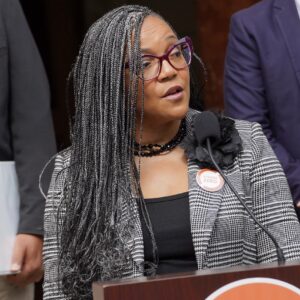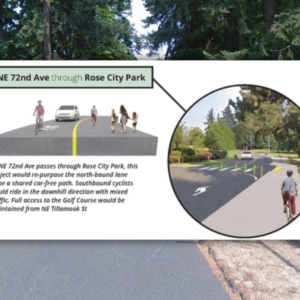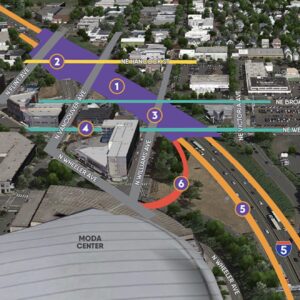
two major projects in the
Lloyd District.
(Photo © J. Maus)
Back on Friday, we shared a major update on the City of Portland’s NE Holladay Street project.
Here’s a quick rewind: After a stakeholder advisory committee (SAC) spent almost a year debating, refining and compromising a proposal to vastly improve bike access on Holladay, the committee voted 12-1 in favor of moving forward with it. However, after being approached by a major business owner in the Lloyd District (the same person who voted no), the Bureau of Transportation (PBOT) decided to hold off on the Holladay project and take a look at Multnomah Street instead.
Now there’s an effort afoot to consider major changes to Multnomah Street which could include a road diet and the return of on-street auto parking.

On Friday I reported that the Holladay project was essentially dead in the water. I was told by PBOT spokesperson Cheryl Kuck that project manager Ellen Vanderslice said they wouldn’t move forward on Holladay due to a lack of consensus by the SAC.
“Yes, there are major property owners who have concerns about the proposed changes on Holladay… We realized that we have mutual interest in looking at something with more magnitude.”
— Tom Miller, Director of PBOT
However, I have since discussed the projects with PBOT Director Tom Miller and have learned that, according to him, the Holladay project is “alive and well.” “This notion that Holladay is dead is inaccurate.”
“Yes, there are major property owners who have concerns about the proposed changes on Holladay,” Miller said via telephone earlier this week. Miller said he feels Holladay is a “good project” and one that his bureau could “advance in short order.” So why is Miller supportive of shifting attention to Multnomah? He feels it has much more potential in the long term and he’s excited to have the support of major Lloyd District property owners.
“We [PBOT and property owner and project stakeholder Ashforth Pacific] realized that we have mutual interest in looking at something with more magnitude.” Multnomah is a “much bigger prize [than Holladay] for those who consider themselves advocates of livable streets” says Miller.

He also feels Multnomah has “underperformed” from a transportation and planning perspective for decades. The street, which currently has five standard lanes and bike lanes in both directions, “hasn’t come together” despite its attributes. Multnomah has bike lanes, it’s just one block away from two light rail lines, and it’s close to downtown. However, in Miller’s words, Multnomah is “still too auto-centric” and therefore it doesn’t encourage the presence of people — a major ingredient of a vibrant street.
Miller feels that the proposed bike access improvements on Holladay “wouldn’t materially enhance the street-level vitality every agrees it needs.”
“Right now we have this auto-centric corridor and the major property owners have said we’re willing to rethink Multnomah in a radical way if PBOT is willing to do so.”
— Tom Miller
With powerful property owners supporting the project from the outset, Miller sees a rare opportunity to make significant changes to a major east-west arterial through the Lloyd District.
“Right now we have this auto-centric corridor and the major property owners have said we’re willing to rethink Multnomah in a radical way if PBOT is willing to do so.”
Central to Ashforth Pacific’s success in getting Miller and PBOT to even consider Multnomah is that they refuted PBOT’s old traffic counts. Initially, PBOT was operating under the assumption that there was too much auto traffic on Multnomah to have it be put on a diet. But after further analysis by City Traffic Engineer Rob Burchfield, PBOT decided it would be possible to reconfigure the street.
“On-street parking is crucial to the success of major, at-grade retail… Retailers need those [parking] stalls. Whether people like it or not, we’re not going to put retail out of business. It’s just not what we do.”
— Tom Miller
It remains to be seen what shape the Multnomah project will take (there will be a public process if it moves forward). But one change is almost certain: On-street auto parking would be added onto the street. Miller feels that “on-street parking is crucial to the success of major, at-grade retail… Retailers need those [parking] stalls. Whether people like it or not, we’re not going to put retail out of business. It’s just not what we do.”
Adding more car parking is also likely a key enticement for property owners who see a direct value connection between parking, property values, and retail success.
Along with the addition of on-street parking, Miller says he’s been “explicit” with property owners that any major changes to Multnomah must come with a “world-class bikeway” — especially if nothing moves forward on Holladay. By “world-class”, Miller is thinking something along the lines of a physically separated bikeway similar to what PBOT built in the Cully neighborhood or a buffered bike lane line the ones on SW Stark and Oak downtown.
In addition, Miller says he would expect that improvements made to Multnomah would be paid for by Lloyd District businesses and property owners (probably through a new local improvement district (LID) tax)
While he’s bullish on Multnomah, Miller maintains that he isn’t forgetting about Holladay. In fact, he sees the ultimate outcome being both projects being implemented. “Down the road I can imagine where we have a world-class cycle track on Multnomah and the improvements on Holladay.”
Miller compared future Multnomah-Holladay bikeways as similar to SE Hawthorne and Clay. Hawthorne (west of 12th) is a major bike street with a wide bike lane and bike boxes while Clay is the parallel, lower-stress neighborhood greenway option.
“We have a good opportunity in Holladay, and we have a potentially transformative opportunity with Multnomah… I can see a day when we can do both.”
Stay tuned. It will be very interesting to see how all this shakes out.





Thanks for reading.
BikePortland has served this community with independent community journalism since 2005. We rely on subscriptions from readers like you to survive. Your financial support is vital in keeping this valuable resource alive and well.
Please subscribe today to strengthen and expand our work.
a 12-1 vote sounds like a pretty strong consensus to me.
Remember, Ashforth-Pacific is no longer a player…their former stake in the Lloyd District is now owned by Langley Investment Properties.
http://www.ashforth.com/triangle11-2_ashforthpacific.html
According to portlandmaps.com, Multnomah only has 10,000 cars per day. The current 5 lane cross section is seriously overbuilt.
If on street parking must be included:
() Please price it the same or higher than surface lots. It should be higher simply due to the convenience factor.
() Include in the agreement for this new on street parking an automatic annual price adjustment that takes in to account inflation and property values
)) better yet make a requirement for an SFpark style pricing scheme.
() Don’t remove bus stops for the convenience of on street parking.
() Don’t add new safety hazards for cyclists and pedestrians for the convenience of on street parking.
I’ve been riding along Multnomah to drop off and pick up my kids at preschool, and my wife rides the whole distance often. Even at 7:30 AM or 5:30 PM there is little traffic. As long as the new configuration is good for buses, I think adding parking could work out well. A parking-protected cycletrack or bike lane would be great; buses could have stops, with a waiting area in the parking lane, separating bikes and buses. But I would love to see a two-way bike route on Holladay as well, even if it does not connect further east currently; it will be great once the Sullivan’s Gulch trail is done, and for getting to MAX
Let’s be clear on one thing: the cycle track on Cully is pretty nearly “world class” — the buffered lanes on Stark and Oak are definitely not.
ha! agreed Carl. I think what Tom was doing was not wanting to over-promise anything or limit the discussion of options.
Agreed! Another random example of excellent cycletrack design is in Beaverton, of all places, along a stretch of 155th by sexton mountain: http://g.co/maps/xvvfn
Toss in some bump outs for bus stops & we’d be good to go.
i don’t think a cycle track that meanders needlessly and reduces visibility at every intersection is world class. the cully cycle track is a glorified sidewalk with all the attendant risks.
ths cully cycle track is a perfect example of how portland favors preservation of parking spaces over cyclist safety.
Aghghgh. If they are going to do Multnomah, I hope they figure out all cars in and out of the parking lots, the buses pulling into the bike lanes, and when heading west the unfortunate merge across two lanes while swooping down under the I-5 to make the left turn into the Rose Quarter transit center.
so, in return for more on-street parking I can only assume they plan on ripping out the giant underutilized garages and replacing them with parks.
*eyeroll*
“Retailers need those [parking] stalls. Whether people like it or not, we’re not going to put retail out of business. It’s just not what we do.”
Huh? What is world class about that kind of thinking? Last time I checked, businesses all over town were clamoring for on street bike parking in front of *their* businesses. Are retailers on Multnomah without the to-be-added on-street car parking still in business? If so, what is Miller talking about? As I’ve said here before, if a retailer can’t make it without abundant on-street car parking then maybe they need to think about how they’re going to make it when abundant on street cars are no longer a given.
How can Miller propose increased car parking and world class cycling infrastructure in the same sentence on the same street? What am I missing? Maybe a diagram of what is being suggested would help?
The concept on Holladay was ALWAYS to remove on-street stalls. The Stakeholders Advisory Committee interviewed each of the street-level storefronts from Grand to 13th, and of all those business only two who were concerned about parking removal–they are across from the MAX stop between 11th and 13th.
right now there are two travel lanes in each direction, a center turn lane, two bike lanes (so-called) and zero onstreet parking. if you substituted parking for a travel lane in each direction, and used it to buffer a wide bike lane, then in theory you could increase onstreet parking and get a something-class bike facility on the same street and in the same breath. as ian stude notes below, the idea is that an entire block between i think eighth and ninth or thereabouts would be developed with high density residential and street level retail. miller was saying ashforth would pay for the necessary studies, and he thought multnomah could be developed as a bike/ped friendly street in conjunction with holladay, rather than “instead of.” we will see.
At last night’s Bicycle Advisory Committee Mtg, Tom Miller mentioned that at least one of the surface parking parcels is likely to be developed into a sizable building with ground-floor, street-focused retail. Not exactly what you were asking for, but certainly a good reason to look for opportunities.
Sidenote: I had thought that N. Williams might be our city’s first commercial corridor to incorporate a world class bikeway. Looks like it might turn out to be Multnomah. Unfortunately, it’s hard to see the Lloyd District becoming a hotbed for bicycle friendly businesses. I would loved to be proved wrong on that though!
It appears that any opportunities for new street level businesses along Multnomah would require the repurposing of the existing superfluence of parking lot space.
I would love to see this process incorporate the Lloyd District’s long-stated intentions for an eco-district…
http://djcoregon.com/news/2010/05/19/lloyd-district-will-be-portlands-first-eco-district/
…which would include improved sustainability features including transportation infrastructure and green streets
http://www.pdxinstitute.org/index.php/ecodistricts
I hope that the Lloyd District Sustainability Director is included in any ongoing discussions about an east-west bikeway, whether Holladay or Multnomah.
http://socialenterprises.wordpress.com/2011/10/26/ecodistricts-11-scaling-innovation-sarah-heinicke/
I hope that if cycle tracks are implemented that 1) Conflict between buses and bikes is reduced through the same means this is accomplished in the Netherlands and 2) that there is thoughtful intersection design. Parking should not compromise ‘world-class’ or safety
Come on Portland, show the rest of us that you’ll achieve the goal of 20% of trip by bike!
Who holds the bigger stake?
Holladay or Multnomah?
I personally do not enjoy cycling up Multnomah. From the Rose Quarter to MLK Jr Blvd, the grade feels more acute than when I cycle up along Holladay. Does any one know what the grades are on the respective climbs from the Rose Quarter to MLK Jr Blvd? Is there a site online that has that information?
I have strong reservations about Multnomah being the primary, cycling route being advanced by the city rather than Holladay for the neighborhood. I do hope that Holladay is not forgotten or abandoned. With new staff and new budgets it is easy to imagine this happening which is why I’d like to see it developed *now* instead of a promise that could fade away (particularly with diminishing budgets for all government bodies).
Topography and grade are serious considerations which are frequently ignored by the bike route planners at PDO; I’ve never quite figured out way, other than they spend too much time looking at street grid maps that don’t include topographic contours, or they have never ridden the proposed routes themselves.
For example, the SE Salmon Bike Boulevard climbs to the top of the largest hill between SE Hawthorne and SE Belmont; either SE Yamhill or SE Madison are much better routes to use to avoid the largest hills between SE 20th and SE 39th.
Yeah, I always found Salmon a funny choice as a bike route given how amazingly easy Yamhill is in comparison.
Paint is cheap, they dont need to spend a fortune physically rebuilding the street
Separated cycle tracks are awesome, except they dont really function when you have a driveway or cross street every 50 feet creating abundant conflict points with autos. Hence why they work in old European cities where each buildings doesnt have off-street parking needing access across the cycle track.
Maybe if the Lloyd developers developed their parking lots it would be a little less auto-centric. I agree with Tom Miller on on-street parking, I’d rather have parking on-street (with buildings oriented to the street) than to waste valuable land on off-street parking that can be used for buildings (its a city afterall).
Good to see some commonsense out of a traffic engineer. It drives me up the wall that traffic engineers are typically so overly concerned with maintaining free flow traffic on all streets at all costs… “sorry this street has to stay as a Traffic Sewer because our MUCTD manuals say we cant have any streets with backups or travel below 30 mph”… big deal if a street goes on a diet and it takes 30 seconds longer for a car to travel it.
It’s a myth! They have driveways in the Netherlands! Be enlightened!
http://hembrow.blogspot.com/2011/08/but-we-have-driveways.html
Anything less than a grade-separated, buffered bikeway with signals and signage cannot be considered “world-class”.
why exactly do you need grade separation on a street where the traffic is moving at less than 20 mph
Agreed. I really, really, really( 3 really’s!) don’t believe they know what they are talking about when they say “world-class” (prove me wrong). More paint? another turn signal with a bike icon? Sure, sure, good and well to an extent, but World Class? Highly doubtable. I’ll believe it when I see it, and I’m not completely convinced everyone is so perspicacious.
What’s the significance of PBOT using inaccurate traffic counts in a study of this magnitude? If they truly were making plans for redevelopment without getting such easy-to-obtain data correct, it doesn’t inspire my confidence in their ability across the spectrum. Did I misunderstand?
I didn’t have time to ask Miller last night, but one would hope that if the “superblock” between 7th and 9th and Multnomah and Holladay were developed (with residential towers and groundfloor retail as I think he said), then the “superblock” would be split two ways with streets, or at least pedestrian and bike rights-of-way, to start breaking down the scale of the blocks in Lloyd District, back to a more pedestrian-friendly 200 x 200 feet. This will give more retail frontages, more places to walk, and more public space in the midst of a giant private development.
Whoa! 18 total blocks of safer bikeways that empty you onto busy car dominated roadways with transit busses, MAX tracks, or major cross traffic at either end. Transformative!!! Tell the Dutch they just lost to “world class” Portland.
remove two car lanes, use on street parking to support a buffed bike lane. done.